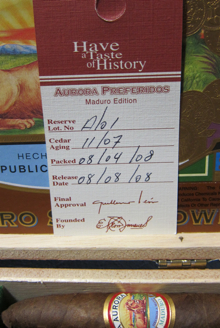Like most hobbies, there’s plenty of jargon when it comes to cigars. Vintage, puro, hand-rolled, aged, hand-bunched, maduro, oscuro, natural, bundled, mixed-filler, short-filler, entubar…There are so many terms out there, even the most well-informed consumers are likely to have trouble keeping track of them all.
 And when these terms appear on a box of a cigars or in a cigar catalog, it’s often hard to hard to separate the marketing hyperbole from the facts. Does the handmade cigar industry need better labeling? If so, who should decide what those standards are and how they might be enforced?
And when these terms appear on a box of a cigars or in a cigar catalog, it’s often hard to hard to separate the marketing hyperbole from the facts. Does the handmade cigar industry need better labeling? If so, who should decide what those standards are and how they might be enforced?
A recent article in Wine Spectator (sister publication of Cigar Aficionado) got me thinking about these questions. It discusses the Alcohol and Tobacco Tax and Trade Bureau’s (TTB) recent call for comments on proposed wine labeling rules that would dictate under what conditions wine makers can include certain terms on their labels.
Many of the terms specifically mentioned—estate, estates, estate-grown, reserve, old vine, barrel-fermented, proprietor’s blend, single vineyard, old clone, vineyard select, select harvest, bottle-aged, and barrel select—are quite similar to terms used in cigar making. And their cigar counterparts can be just as confusing. Vintage, for example, can refer to almost anything: the wrapper’s age, the harvest of tobacco that makes up the cigar, the year the cigar was made, or some combination of those definitions. Most of the time, it’s enough to drive a consumer crazy.
So should cigar smoker’s call in the TTB and demand standardization? Quite the opposite. Cigar enthusiasts should be weary of further government intervention.
As the Wine Spectator article notes, “small wineries could be hurt by the costs of complying with new or retooled regulations in general.” Similarly, tracking the exact age of every tobacco leaf in every cigar could impose huge costs on smaller boutique cigar makers, stifling the innovative blending that smaller cigar makers bring to the market. Besides, the FDA is already breathing down the neck of cigar makers, and the cigar industry already has to deal with enough TTB regulations.
Absent government intervention, there can still be more disclosure about the contents of the cigars we purchase. There are plenty of private organizations—Tobacconist University and the Cigar Association of America come to mind—that could provide standards for labeling that would give cigar consumers the information we want.
Cigar makers who want to participate in this system could voluntarily adhere to a set of standards, agreeing to only use terms like vintage, puro, or single region when they meet the agreed-upon definition. Those who feel such standards would be too burdensome won’t be coerced into participating. A simple seal can be displayed only by those who participate.
Such a system would let cigar consumers know what participating cigar makers mean when they use terms that are otherwise vague. And, more importantly, smokers would know to take the claims of cigar makers who don’t participate with an appropriate grain of salt.
–Patrick S
photo credit: Stogie Guys


 1) U.S. Customs officials seized 30,000 Cuban cigars when the illegal smokes arrived at Chicago’s O’Hare airport this week. “The flood of the popular contraband is the biggest seen at the Customs and Border Protection’s Chicago field office, which typically seizes 10 to 12 cigars a week at the O’Hare international mail facility,†reports the
1) U.S. Customs officials seized 30,000 Cuban cigars when the illegal smokes arrived at Chicago’s O’Hare airport this week. “The flood of the popular contraband is the biggest seen at the Customs and Border Protection’s Chicago field office, which typically seizes 10 to 12 cigars a week at the O’Hare international mail facility,†reports the  Chances are you’ve got at least one cigar enthusiast on your shopping list. Be it a father, an uncle, a friend, or a co-worker, it’s important to keep in mind that tastes in cigars vary widely. Some people are averse to specific brands based on past experiences, some only like very mild or very strong cigars, some are maduro smokers or Cuban snobs, and some are just plain picky. Whatever the case, here are seven simple rules that will help you choose the best gift for your favorite cigar smoker:
Chances are you’ve got at least one cigar enthusiast on your shopping list. Be it a father, an uncle, a friend, or a co-worker, it’s important to keep in mind that tastes in cigars vary widely. Some people are averse to specific brands based on past experiences, some only like very mild or very strong cigars, some are maduro smokers or Cuban snobs, and some are just plain picky. Whatever the case, here are seven simple rules that will help you choose the best gift for your favorite cigar smoker: And when these terms appear on a box of a cigars or in a cigar catalog, it’s often hard to hard to separate the marketing hyperbole from the facts. Does the handmade cigar industry need better labeling? If so, who should decide what those standards are and how they might be enforced?
And when these terms appear on a box of a cigars or in a cigar catalog, it’s often hard to hard to separate the marketing hyperbole from the facts. Does the handmade cigar industry need better labeling? If so, who should decide what those standards are and how they might be enforced? But you’ll then want to turn to the newer Maduro line. Priced as pleasingly as its lighter twin (about $5-6 per cigar), the dark La Traviata is another
But you’ll then want to turn to the newer Maduro line. Priced as pleasingly as its lighter twin (about $5-6 per cigar), the dark La Traviata is another 
 The Oliva Cigar Co. has only been around for about 15 years. In that short time, this decorated Nicaraguan manufacturer has built a well-deserved reputation for quality and affordability. The brand’s foundation is built on blends like the Habano-wrapped Serie V and the Cameroon-wrapped Serie G—two highly-rated cigars that can be bought on the cheap.
The Oliva Cigar Co. has only been around for about 15 years. In that short time, this decorated Nicaraguan manufacturer has built a well-deserved reputation for quality and affordability. The brand’s foundation is built on blends like the Habano-wrapped Serie V and the Cameroon-wrapped Serie G—two highly-rated cigars that can be bought on the cheap. Patrick Ashby
Co-Founder & Editor in Chief
Patrick Ashby
Co-Founder & Editor in Chief Patrick Semmens
Co-Founder & Publisher
Patrick Semmens
Co-Founder & Publisher George Edmonson
Tampa Bureau Chief
George Edmonson
Tampa Bureau Chief